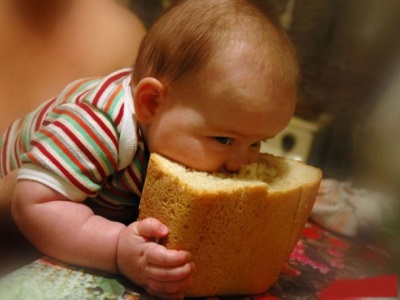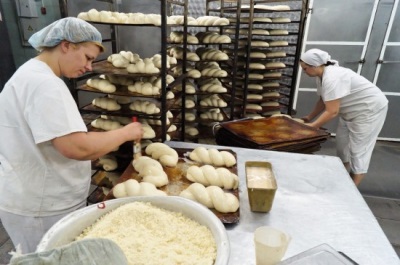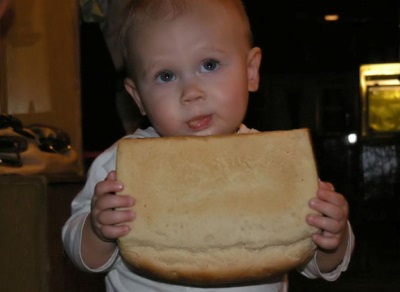At what age can you give bread to a child?
Bread appears regularly on the table of most families and is among the most popular products. Therefore, after the birth of the baby and the beginning of the introduction of complementary foods, each mom has questions about including him in the children's menu - when can you give, how much to offer crumbs and what kind of bread is most useful for kids?
How to bake
The simplest bread recipe includes flour, water, yeast and salt. It can expand by adding vegetable oil, milk, eggs, sugar, whole grains, butter, seeds and many other ingredients.
Flour is used not only wheat, but rye, corn, buckwheat and other. Also, the modern food industry produces bread in which the content of some components is reduced, for example, a loaf with a smaller amount of starch, salt or protein.
Many kids are interested in how bread is made and they listen enthusiastically to mom's story about baking it. Helping children to learn the details of making bread help pictures or video. For example, The kids can watch a cartoon from the “Secret to the World” series presented below, in which a puppet wolf makes a tour of the factory, where tons of bread are baked daily. From this video, children can learn how to knead the dough, what is yeast and how they help in baking, as well as how to make a rifled loaf.
Benefit
- He noted balanced nutrient composition. It contains beneficial vegetable proteins, as well as complex carbohydrates. He also acts as a source of many vitamins (B1, PP, B3, E, B6 and others) and trace elements (Mg, K, Mn, Fe, Ca, P, etc.).
- In rye bread a lot of dietary fiber and high content of vitamins of group B.
- Pleasant smell activates the production of digestive juices, thanks to which the food is absorbed faster.
- Bread with the inclusion of whole grains, bran, seaweed, flaxseed, sesame and other additives enriches the diet with minerals and fiber.
Possible harm
- Due to the content of oligosaccharides, enzymes for the digestion of which are absent in young children, its learning in the first years of life is difficulttherefore, the Borodino bread cannot be included in the diet of a child under 1-1.5 years old.
- Baked from wheat flour product is a source of gluten, which some children have allergies. Also, an allergic reaction is possible on baked goods containing eggs.
- A roll baked from white flour with added butter and sugar brings little use to the baby’s body, because during the manufacture of rich products lose vitamins. In addition, similar pastries are high in calories. It is not advised to include in the menu of children under 2-3 years of age.
- In the freshly baked form, it is not recommended for children under three years old due to high gluten content.
- If you give bread to babies who chew food badly, this can be dangerous (the crumb will not chew it well and can choke).
- The child can have a snack for them, which is why his appetite will decrease by the time of the main meal. Because of this, children can refuse other healthy foods, such as vegetables.
- Excessive consumption of black bread can interfere with the absorption of iron and provoke anemia.
From how many months in the feed?
From 7 months of age Babies can try products similar to bread - crackers and baby cookies. White bread appears in the diet of babies with any type of feeding in 8 months in the amount of 3-5 grams per day. The same portion is offered. 9 month old baby, and from 10 monthin a year, the wheat product begins to give 10 g per day.
From year to year the amount of white bread in the child’s diet is gradually increased. If, after including it in the children's menu, the toddler has colic, bloating, restless behavior or stool disorders, you should contact your doctor. The doctor will help determine the cause and prevent problems with the further addition of bakery products to the baby's diet.
The inclusion in the children's menu of black bread and bakery products with different additives, for example, with bran, pediatricians, among whom Dr. Komarovsky, is not recommended until 1.5-2 years of age. You can acquaint yourself with the black bread of a child at 1.5 years old, giving the crumbs a maximum of 10 g of this type of baking.
The release of Dr. Komarovsky’s program on a variety of baby foods, see below:
A two year old child give up to 100 grams of bread per day - up to 70 grams of wheat and about 30 grams of rye. Daily portion for a child over three years old increases to 150-170 grams, including about 50-60 grams of rye bread. Schoolboy give 200-300 g per day, offering black bread in the amount of 75-150 g
When and how to give?
For the first time, a piece of bread should be offered to the baby in the morning, so that a possible allergic reaction to such a new product can be traced. It can be soaked in any liquid, for example, a mixture, baby tea or soup. Next, it is given in the lunch feeding to the soup, vegetable puree or meat dish. Increasing the daily portion, it is also offered for breakfast or during the snack.
How to choose and store?
When buying bread that will be eaten by a child, it is important to pay attention to its freshness and appearance. The loaf should be the correct form and smooth, without burnt areas or dents. Do not buy bran fruit or wholegrain loaf to children under 3 years old. Also, do not buy for young children loaves. The best choice would be the usual "brick".
Storage time is small and amounts to 24-36 hours. Store different varieties separately. If you keep a loaf in the bread box, it must be regularly aired and treated with vinegar.
How to bake?
For complete confidence in the safety and freshness of the bread, many mothers decide to bake it for the baby on their own. The easiest way would be to use a bread machine, because in this machine it is enough to place the ingredients and select the desired program. You can also knead the dough with your hands and bake a loaf in the oven.
For the first bread, which can be given to a baby, take about 450 g of flour, 1.5 tsp of dry yeast, 1 tsp of salt and 2 tbsp. l vegetable oil. If you want to use fresh yeast, they are first diluted with warm water, and for children older than a year - with warm milk.
If the child refuses to eat
To worry about the refusal of the baby to try bread should not be. If cereals are present in the diet, his body will receive complex carbohydrates and B vitamins from them. Although such a product is present in the diet of most of our compatriots, people can easily do without this product. Provided that their food is varied and includes a sufficient amount of vegetables, cereals, meat, dairy products, fruits, fish.
On the benefits and harms of the Borodino bread look in the program "To live healthy."































































